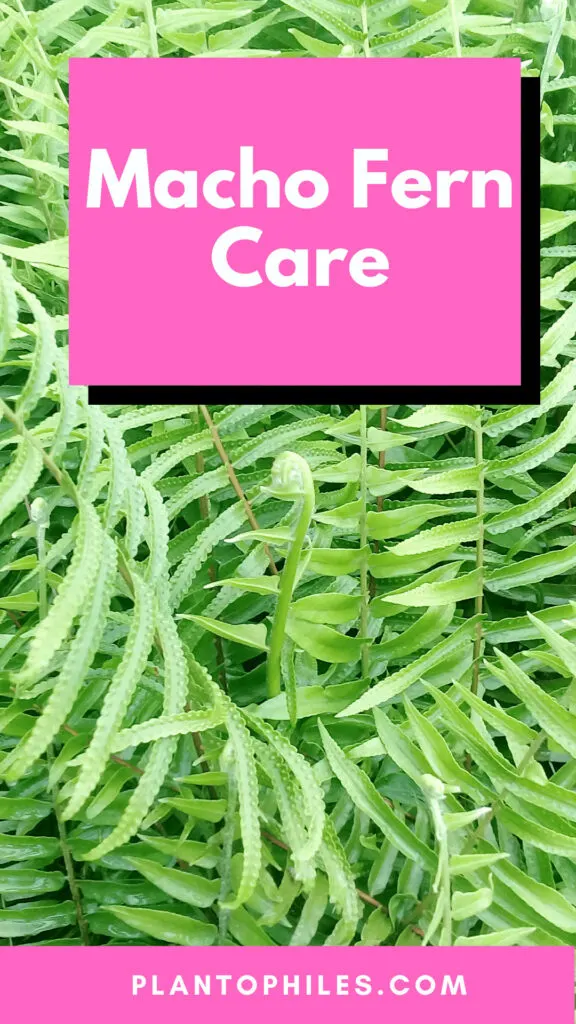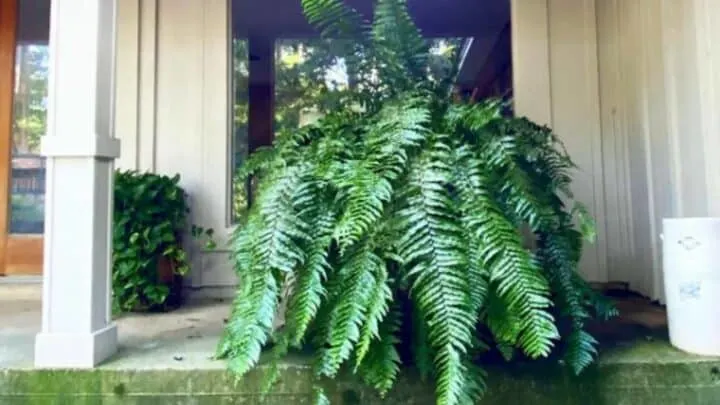You are here to read more about Macho fern care and Nephrolepis biserrata (scientific name) as a plant. Macho ferns can be seen adorning porches, patios, shaded gardens, and indoor spaces.
I have a Boston Sword Fern in front of my house and one in my winter garden. Ferns are not easy to care for, in my experience.

Takeaways
| Species | Nephrolepis biserrata |
| Synonyms | Sword Fern, Boston Sword Fern, Wild Boston Fern, Fishbone Fern |
| Family | Nephrolepidaceae |
| Genus | Nephrolepis |
| Growth | Compact, spreading |
| Height | 2.0 |
| Width | 3.0 |
| Soil | Well-draining soil mix |
| Watering | Min: 7.0, Max: 14.0 |
| Light | Bright indirect |
| Temperature | Min: 60.0°F (15.6°C), Max: 80.0°F (26.7°C) |
| Humidity | Min: 40.0%, Max: 70.0% |
| Fertilizer | 12.0 |
| Propagation | Division of rhizomes or spores |
| Toxicity | Not toxic to humans, cats, and dogs. |
Macho Fern Plant
Nephrolepis biserrata, commonly known as the Macho fern or Sword Fern, has massive, burly foliage. The Boston Sword Fern earns its name due to the space it occupies and its bold but graceful look.
Table of Contents
Macho Fern Care
Good soil drainage and aeration are a must for Macho ferns. It will thrive in shaded or partially shaded locations. Bright indirect light for 4-6 hours a day is needed. Water this plant every time the top layer of the soil dries out. The ideal growing temperatures for the fern are 50-80°F (10-26°C).

Macho fern hardiness
The Wild Boston Fern is hardy up to USDA hardiness zone 9-10.
Soil
The Macho fern plant thrives in well-draining, loamy or sandy soil.
The soil should needs good water retention. as the plant does not like to be left without water for a long time. This plant will love soil rich in organic matter and prefers it slightly on the acidic side (pH 6-6.5).
In nature, the Fishbone fern (Macho fern) can be spotted growing in locations with varying atmospheric and soil conditions. This plant can grow anywhere from around ponds and swamps to rock crevices.
It can also be found growing as an epiphyte on bigger plants. This tells us that the beautiful Sword fern is well suited to various soil types, whether sandy, loamy, or rocky.
Although it’s not very picky about the soil type, this plant will not do well in waterlogged soils. Good soil aeration and drainage are a must. The plant’s health will quickly deteriorate if the soil does not have these characteristics.
Nephrolepis biserrata usually grows on the forest floor under the dappled shade of the forest canopy. Forest floors are naturally rich in organic matter, which helps the fern to thrive.
Use well-aerated and well-draining soil when planting a Boston Sword fern in your garden or a pot.
If you think your garden soil is too heavy, add a combination of potting media such as organic compost, perlite, and coco peat to make the soil lighter.
Use these to fill the hole before placing the root ball inside, and then fill it up on all sides.
When growing this plant in a pot, you can use the recommended houseplant potting mix for your Macho fern. To customize the mixture to a fern’s liking, add the organic content to enhance fertility, soil drainage, and water retention.
Macho fern Sun (Lighting)
The Macho fern does not need a lot of sun. It will thrive in shaded or partially shaded locations. Bright indirect light for 4-6 hours daily is more than enough. Protect this plant from direct sunlight, as it can burn the foliage. Mild morning or afternoon sunlight will serve the fern well.
One thing that makes the Macho fern a perfect houseplant is its required light levels. It will do well in any shaded place, and you will not have to worry about the plant not getting enough light.
Outdoors, these plants cannot be grown in open, unshaded spaces as staying in direct sunlight for extended periods will kill them.
They are best grown next to walls that provide shade during the hottest part of the day or under trees. A linear Macho fern plantation looks good when planted alternatively to a linear tree plantation.
If you’re growing a Macho fern in planters, it can be easily grown on your porch or patio in the summer. The bright indirect light in these locations is ideal for this plant.
If you have to bring your fern indoors for the winter, remember not to place it somewhere too dark for its liking.
Make sure it gets bright indirect light by placing it next to a North or East facing window.

How often should I water my Fishbone Fern?
The Macho fern requires water in moderation. It does not like being left thirsty for long and will thrive if its soil is consistently moist. Water this plant every time the top layer of the soil dries out. Do not water heavily, but only to make the soil moist and not soggy.
If there is one department of Macho fern care that can seem most demanding, it is the watering requirements.
Macho ferns like a consistent moisture supply but will not tolerate excessive moisture. The key to watering this tropical plant is to keep supplying small amounts of water with short intervals in between.
Usually, we water our houseplants heavily once most of the soil has dried out. We cannot follow the same watering practice with a fern.
You cannot allow the soil to dry out fully, nor water the plant heavily so that the water sits in the pot for a long time.
You can make caring for a Macho fern, especially the watering, easy for you by using water-retaining soil.
Using highly organic soil or adding water-retaining ingredients to the soil reduces the risks of overwatering and even underwatering your plant.
If your Macho fern is suffering from a lack of soil moisture, the foliage begins to lose its coloring and starts shedding leaves.
Temperature
Macho ferns are tropical plants and prefer warmer temperatures. They are also tolerant to relatively low temperatures when compared to other houseplants. The ideal growing temperatures are 50-80°F (10-26°C).
Macho ferns are naturally found on tropical forest floors, a highly protected environment with temperatures between a highly regulated range.
They like temperatures on the warmer side but will suffer if the mercury rises too high or dips too low.
Macho ferns cannot tolerate temperatures below the freezing point. Neither will they like temperatures above 95°F (35°C).
If you live in cooler climates, you must overwinter your Macho fern indoors or in a protected greenhouse.
Humidity
Optimum humidity levels are critical for a Macho fern to thrive. All tropical plants love humid conditions, but ferns, in particular, need high humidity to grow lush, healthy foliage. A Macho fern typically enjoys humidity above 70% in its native habitat.
Due to their high humidity preference, Macho ferns are the perfect plant to grow in bathrooms.
Given adequate natural light in your bathroom, you can fill the whole place with Macho ferns to enjoy the humidity and fill every space in your home with plants.
In typical indoor environments, especially in the winter, humidity levels are too low, and tropical plants such as the Macho fern are prone to suffer.
To notch up on the humidity levels for your plant, you can use a pebble tray filled with water. Using a humidifier is also a good idea if you have more plants that need high humidity.
Misting your Macho fern is an option, but it can often lead to fungus-related problems if the water stays on the foliage for too long in warm and dark conditions.
Fertilizer
Fertilizing your Macho fern is unnecessary, as this plant will do equally well otherwise. The organic matter present in the soil is more than enough. Once in a while, fertilization with an all-purpose formula will ensure healthy and vibrant foliage.
Overfertilization is a danger you want to avoid at all costs. You can damage half or more of your healthy Macho fern just by adding too much fertilizer.
Water your plant before you add fertilizer to avoid root tip burn and reduce the risk of over-fertilizing your plant.
Growth
Mature Macho fern plants can grow as wide as 6 feet and 4 feet tall. Each frond can grow 3-4 feet long with bold, broad, gently toothed leaves. The stems have very thin, reddish hair on their surface.
The Macho fern is considered a threatened species in the USA because of the rapid loss of its natural habitat.
It is a great ground cover because of its spreading ability and can also do well in vertical plantation styles.
The fronds of a Macho fern spring out from the plant’s core in different directions, giving a bold, jazzy look.
The foliage looks deep green at the base of each leaf and turns light green at the tips.
Can I put my Macho fern in a Hanging Basket? (Potting)
Macho ferns grow best in large containers or hanging baskets at least 8-10 inches in diameter (20-25cm). This plant will grow laterally, and you will need a bigger pot every subsequent year. Terra cotta pots are recommended because the soil stays well-aerated in them.
Macho ferns need macho pots. This tropical plant will not grow for long in a small pot and will demand more growing space every growing season.
Using terra cotta pots is a good choice for Macho ferns because this material prevents the risk of root rot.
Pruning
Although Macho ferns are rapid growers and can outgrow their space quickly, pruning is not necessary for Macho fern care. Removing dead fronds and highly damaged fronds is recommended to encourage new, healthier growth.
You can prune your Macho fern from the edges to prune it to a round or cloud shape. You can also remove crisscrossing stems to give the plant a tidier look.
Macho Fern size
The Macho fern grows up to 4 feet in height (122 cm) and 6 feet in width (182). It has a rapid growth rate.
Macho Fern Propagation
Macho ferns are propagated by the division method. New root clumps can be separated from the root ball and planted in separate pots. Ferns do not produce seeds, so they can’t be propagated this way.
If your Macho fern has grown new stems and its pot is getting smaller, you can remove the rootball and separate the new root clumps on the sides of the central root cluster.
The new root clumps can easily be potted in a new pot with houseplant potting mix and placed in a warm and protected environment to get established.
Covering the repotted clumps with a clear plastic bag mimics greenhouse conditions, prevents the plants from drying out, and helps them get established quickly.
The newly divided Macho fern plants will not seem as healthy or bushy at first but will grow healthy foliage after some time.
Sieh dir diesen Beitrag auf Instagram an
Common Problems with Macho Ferns
The Macho fern is a low-fuss plant and does not require a lot of attention. But when the right conditions are not provided, it can suffer from a few common diseases and pests.
Leaf Tip Burn
The leaf tips of a Macho fern can easily dry out due to a range of reasons which include but are not limited to overwatering, excessive sunlight, and low humidity.
There is no way around this problem except to remove the root cause after identifying it. When conditions are right, the plant will grow new and healthy foliage independently.
Nematodes
Nematodes are underground pests that damage the plant’s roots and eventually lead the plant to wilt and die.
They are usually found in mulched soil and are very hard to eliminate. Remove any soil mulches and dead plant matter from the soil to prevent a nematode invasion.
FAQ
Is the Macho Fern Toxic to Cats?
Macho ferns are safe for cats. The Matcho fern is non-toxic to cats, dogs, and humans.
How long do Macho ferns live?
If there are not killed by any external factors, a Macho fern plant can live up to 90 years when provided the right growing conditions.
Does Macho fern clean the air?
As a houseplant, Macho fern is an excellent choice to purify the air and remove pollutants such as VOCs, xylene, and toluene.
Conclusion
Macho ferns are an excellent houseplant for the beginner plant parent. If novice plant growers can get Macho fern plant care right, they get a lifelong plant friend and the much-needed experience they need to grow more houseplants at their place.

Daniel has been a plant enthusiast for over 20 years. He owns hundreds of houseplants and prepares for the chili growing seasons yearly with great anticipation. His favorite plants are plant species in the Araceae family, such as Monstera, Philodendron, and Anthurium. He also loves gardening and is growing hot peppers, tomatoes, and many more vegetables.


